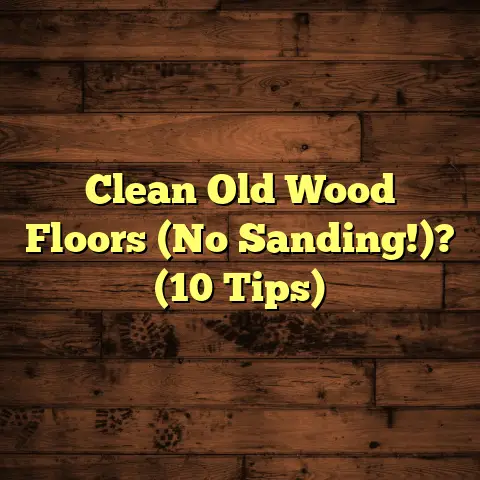Dyson on Hardwood: Use THIS! (3 Head Mistakes!)
And let me tell you, I’ve seen it all when it comes to hardwood floors – the good, the bad, and the downright ugly.
Today, we’re diving deep into a topic that’s near and dear to my heart: Keeping those gorgeous hardwood floors of yours sparkling clean.
And more specifically, how to do it right with a Dyson vacuum!
Introduction: Setting the Scene
Picture this: Sunlight streaming into your living room, dancing across the rich, polished surface of your hardwood floors.
You can almost smell the lemon-scented polish, right?
These floors aren’t just floors; they’re storytellers.
They whisper tales of cozy family nights, boisterous holiday gatherings, and the pitter-patter of little feet (or paws!).
But let’s be real, life happens.
Dust bunnies multiply like crazy, crumbs stage a daily invasion, and allergens? They’re just waiting for an opportunity to crash the party.
That’s where the Dyson comes in – a cleaning powerhouse designed to banish dirt and allergens while preserving the beauty of your floors.
A Dyson can be a hardwood floor’s best friend, but it can also turn into its worst nightmare if you’re not careful.
Trust me, I’ve seen the damage.
We’re talking scratches, swirl marks, and a whole lot of frustration.
That’s why I’m here to share my insider knowledge and help you avoid the most common pitfalls when using a Dyson on hardwood.
So, grab a cup of coffee, settle in, and let’s get ready to transform your cleaning routine from a potential disaster into a hardwood-loving success story!
Mistake #1: Using the Wrong Vacuum Head
Okay, let’s kick things off with the most common mistake I see homeowners making: using the wrong vacuum head.
I can’t stress this enough: Not all Dyson heads are created equal!
Understanding Your Dyson Arsenal
Dyson offers a whole arsenal of vacuum heads, each designed for a specific purpose.
You’ve got your standard brush heads, motorized heads, and specialized heads for everything from upholstery to pet hair.
It’s easy to get overwhelmed, I know.
But when it comes to hardwood, you need to be extra choosy.
The Gentle Giant: The Soft Roller Cleaner Head
The key is to choose a head that is designed specifically for hardwood floors.
And for Dyson, that’s the soft roller cleaner head.
This head is easily identifiable as it is covered in soft woven nylon, with rows of carbon fiber filaments.
I have always found this head to be the best for hardwood floors.
It’s engineered with a soft, fluffy roller that gently glides across your floors, picking up dust and debris without causing scratches.
Think of it as a gentle massage for your hardwood!
The soft roller is designed to pick up both large debris and fine dust, making it perfect for everyday cleaning.
Unlike traditional brush heads, it won’t scatter dirt around or damage the finish of your floors.
The Horror Stories: Consequences of Using the Wrong Head
I’ve seen firsthand the damage that can occur when people use the wrong vacuum head on their hardwood floors.
I remember one client who used a motorized brush head on their brand-new hardwood floors.
The result? A series of unsightly scratches and swirl marks that completely ruined the finish.
They were devastated.
Trust me, replacing or refinishing hardwood floors is not cheap.
According to HomeAdvisor, the average cost to refinish hardwood floors ranges from $3 to $8 per square foot.
And replacement? You’re looking at anywhere from $6 to $22 per square foot, including installation. https://www.homeadvisor.com/cost/flooring/refinish-hardwood-floors/
Moral of the story? Don’t risk it!
Pro Tip: Choosing the Right Head
So, how do you make sure you’re using the right head?
- Read the manual: I know, I know, nobody likes reading manuals. But trust me, it’s worth it. The manual will tell you exactly which heads are suitable for hardwood floors.
- Look for the soft roller: If your Dyson came with a soft roller cleaner head, that’s your go-to for hardwood.
-
Test it out: Before you go all-out, test the head on a small, inconspicuous area of your floor.
If you notice any scratches or swirl marks, stop immediately! * Consider an aftermarket head: If your Dyson didn’t come with a soft roller, consider purchasing one separately.
There are plenty of reputable aftermarket options available that are specifically designed for hardwood floors.
Mistake #2: Ignoring Suction Settings
Alright, now that we’ve covered vacuum heads, let’s move on to another crucial factor: suction settings.
Believe it or not, the suction power of your Dyson can have a big impact on your hardwood floors.
Taming the Beast: Understanding Suction Settings
Most Dyson vacuums come with adjustable suction settings, allowing you to customize the power based on the surface you’re cleaning.
This is a game-changer for hardwood floors.
On one end of the spectrum, you have max suction, which is great for deep-cleaning carpets and rugs.
But on the other end, you have a lower suction setting that’s perfect for delicate surfaces like hardwood.
The Dangers of Excessive Suction
Here’s the thing: Excessive suction can actually damage your hardwood floors.
Think about it: When the suction is too high, the vacuum head can literally stick to the floor, creating friction and potentially scratching the finish.
I’ve also seen cases where excessive suction has actually pulled up loose floorboards or damaged delicate inlays.
Ouch!
Finding the Sweet Spot: Adjusting Suction for Hardwood
So, how do you find the sweet spot?
The key is to use the lowest suction setting that still effectively cleans your floors.
Here’s a simple test:
- Start with the lowest suction setting.
- Run the vacuum over a small area of your floor.
- If it’s not picking up dirt and debris, gradually increase the suction until you find the right balance.
You want the vacuum to glide smoothly across the floor without sticking or causing any resistance.
Bonus Tip: Dealing with Different Types of Debris
Keep in mind that you may need to adjust the suction settings depending on the type of debris you’re dealing with.
For example, if you’re just cleaning up dust and pet hair, a low suction setting should be sufficient.
But if you’re dealing with larger debris like crumbs or leaves, you may need to increase the suction slightly.
Just remember to err on the side of caution and avoid using excessive suction whenever possible.
Mistake #3: Neglecting Maintenance and Care
Last but not least, let’s talk about maintenance and care.
I know, it’s not the most exciting topic, but trust me, it’s essential for keeping your Dyson running smoothly and protecting your hardwood floors.
A Little TLC Goes a Long Way
Think of your Dyson as a high-performance machine.
Like any machine, it needs regular maintenance to perform at its best.
Neglecting maintenance can lead to reduced suction power, clogged filters, and even damage to the vacuum itself.
And guess what? A poorly maintained vacuum can actually damage your hardwood floors.
Essential Maintenance Tasks
So, what kind of maintenance are we talking about?
Here are a few essential tasks:
-
Filter Cleaning: This is probably the most important thing you can do to maintain your Dyson.
Clogged filters can reduce suction power and cause the motor to overheat.
Most Dyson vacuums have washable filters, so simply remove them, rinse them with water, and let them air dry completely before reinstalling.
I recommend cleaning your filters at least once a month, or more often if you have pets or allergies. * Brush Roll Checks: Regularly check the brush roll for tangled hair, string, and other debris.
These can reduce the effectiveness of the brush roll and even damage your floors.
Use a pair of scissors to carefully remove any tangled debris. * Debris Removal: Empty the dustbin regularly to prevent it from overfilling.
An overfilled dustbin can reduce suction power and make it harder to clean your floors. * Hose and Wand Inspection: Check the hose and wand for any clogs or blockages.
These can also reduce suction power and make it difficult to maneuver the vacuum. * Cord Check: Check the power cord for any signs of damage, such as fraying or exposed wires.
A damaged power cord can be a fire hazard, so replace it immediately if you notice any problems.
A Step-by-Step Guide to Dyson Maintenance
Okay, let’s break it down into a simple step-by-step guide:
- Unplug the vacuum: This is a no-brainer, but always unplug the vacuum before performing any maintenance.
- Remove the dustbin: Empty the dustbin into a trash can.
- Clean the filters: Remove the filters and rinse them with water. Let them air dry completely before reinstalling.
- Check the brush roll: Remove any tangled hair or debris from the brush roll.
- Inspect the hose and wand: Check for any clogs or blockages.
- Wipe down the exterior: Use a damp cloth to wipe down the exterior of the vacuum.
- Reassemble the vacuum: Put everything back together and plug it in.
That’s it! With a little regular maintenance, your Dyson will be running like new for years to come.
Conclusion:
So, there you have it – the three most common mistakes people make when using Dyson vacuums on hardwood floors.
By avoiding these pitfalls and following my expert tips, you can keep your hardwood floors looking their best for years to come.
Remember, the key is to use the right vacuum head, adjust the suction settings appropriately, and perform regular maintenance.
With a little care and attention, your Dyson can be your hardwood floor’s best friend, not its worst enemy.
Now go forth and conquer those dust bunnies!
And if you ever have any questions or need help with your hardwood floors, don’t hesitate to reach out.
I’m always happy to help!





